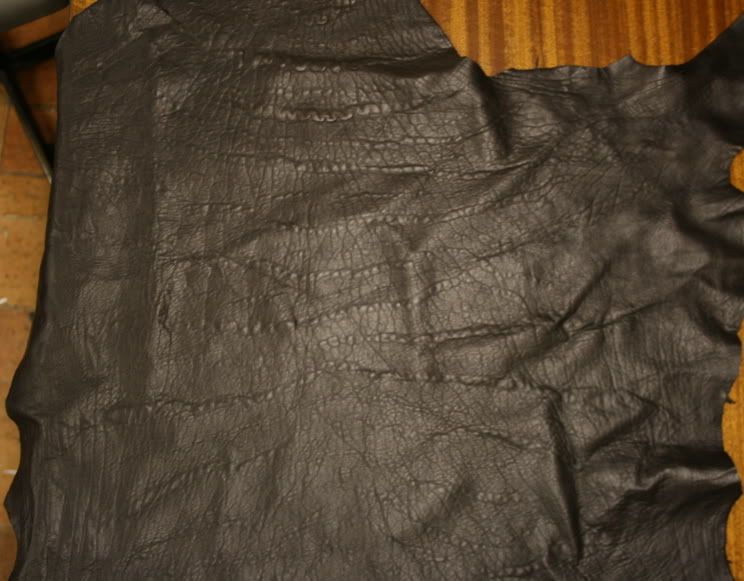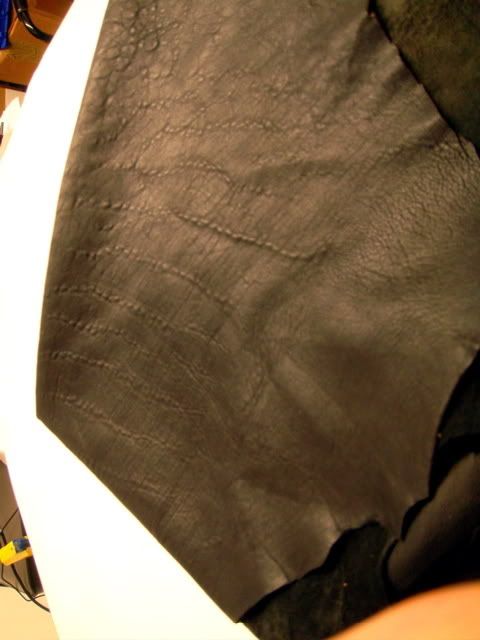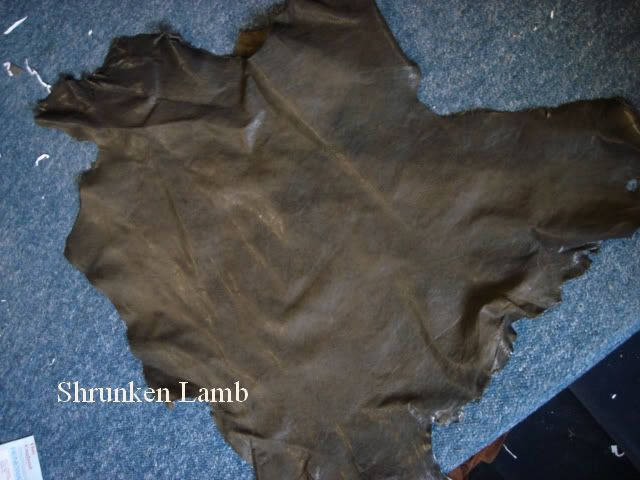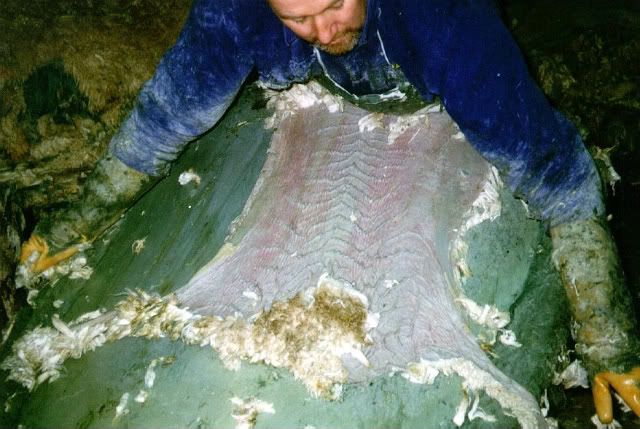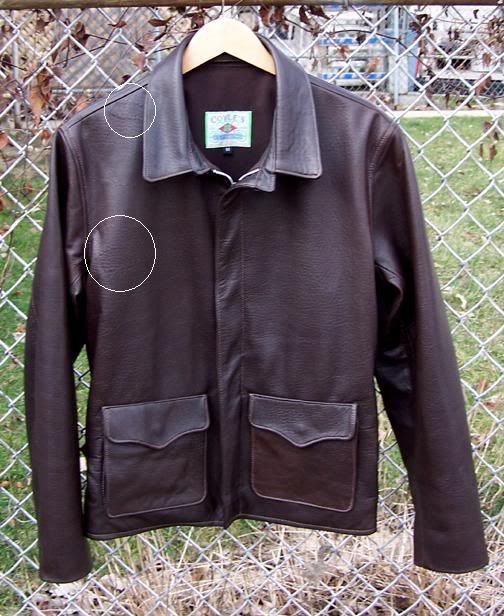Raider's Ripples I asked an expert. UPDATE see first post.
Posted: Sat Jun 06, 2009 12:26 pm
People have relied on jacket makers as experts and they do have a lot of hands on expertise. With my following conversations I found that both our jacket makers are mostly correct, they just use different terms to each other.
I wanted to approach the information from another angle, find an independent expert. I found 3.
I decided to ask someone at the opposite end of the business, someone in teaching. I tracked down a University that specialises in leather.
Northampton University, incorporating The British School of Leather Technology.
"The British School of Leather Technology at the University of Northampton is a world-leader in the provision of leather technical education. The Company's historical interest in the School dates back to 1909, when it established the Leathersellers' Technical College on Tower Bridge Road, London. The College was amalgamated with the leather department at Nene College in 1976 and a new centre for leather education was created with a grant of £500,000 from the Leathersellers' Company. Opened in 1978, the National Leathersellers' Centre was immediately popular with overseas students, and with its growing international reputation in mind, its name was changed to the British School of Leather Technology in 1991.
Facilities at the BSLT include a tannery and extensive laboratories, all equipped with state-of-the-art machinery. Courses on offer range from BTEC certificates to postgraduate research degrees, and there are short courses in specialised areas tailored to individual requirements. The Leathersellers' Company provides on-going support in the form of grants and scholarships, and each year students are invited to attend an awards ceremony at the Hall."
http://www2.northampton.ac.uk/appliedsc ... ience/bslt
http://www.leathersellers.co.uk/simple. ... page_id=36
First I contacted Dr. Paula Antunes Senior Lecturer on the MSc Course and Field Leader - Leather Division
She very kindly put me in contact with Mr Paul Evans the Senior Lecturer for leather technology, In turn he referred me to Doctor David Scobie in New Zealand.
I will present my conversations with these people with as little comment as possible, they should do the talking.
Kt:
Dear Doctor Antunes,
Pardon my email from out of the blue. I was looking for an expert in leather and tanning processes to try and identify a defect in a piece of leather and I wondered if you might be able to help me.
Dr Antunes:
Thank you for contacting us. Our leather division is quite diverse in the subject matter we teach. Unfortunately I am not able help you on this matter, but I have spoken to one of my colleagues who is an expert in leather tanning and he is very happy to help you.
Mr Evans:
My name is Paul Evans I am the senior lecturer in leather technology, if you care to email a photo we can try and help.
KT:
Just so that you know and my apologies really as this is somewhat of a frivolous request. The leather in question is one used in a film on a jacket. You may recognise it, but to try and keep your opinion unclouded I'll not reveal what film to you right now. What I will say is, the jacket was made in 1980 and in the UK, we are told that the leather is lambskin.
There are various jacket enthusiasts who wear period accurate leather and there is a discussion as to what the dots on the chest of this jacket are. In your opinion what do you think caused these marks.
Thank you. Image attached.

Mr Evans:
Thanks – there are one or two things that I can state about the Leather
1 – This Lamb – possibly the meat should have been sold as mutton i.e. an older animal.
2 – Wool sheep – likely to be UK, Australian, possibly New Zealand, from a Merino or Merino X
3 – The dots are what is termed Ribbiness – this is where the skin generally follows the pattern of the ribs
Academic Paper:
Skin wrinkles of the sire adversely affect Merino and halfbred pelt characteristics and other production traits
D. R. Scobie A , C , S. R. Young A , D. O’Connell A and E. Eythorsdottir B
A AgResearch Limited, Canterbury Agriculture and Science Centre, PO Box 60, Lincoln, Canterbury, 8152, New Zealand.
B Agricultural Research Institute, Keldnaholt IS-112, Reykjavik, Iceland.
C Corresponding author.
Abstract
The wrinkles on the skin of Merino sheep and related breeds are retained during leather processing, and the skins are known as ‘ribby pelts’ in the leather trade.
Wool sheep have a very loose structure, when they are very woolly the wool is tightly packed so the skin goes into folds to accommodate this and there is often some delamination between the grain surface and underneath layers due to fat cells, all this gets worse in older animals – therefore true lambs tend to have very little of this problem.
Kt: Thank you for such in depth answers.
I had been told that the dots come from an enzyme added to the tanning process or from a deliberate change in the ph. Is this true?
Mr Evans: Some tanners I have seen in India deliberately encourage the effect – creating a “shrunken” look which accentuates the natural skin variations – this is usually done with pH.
KT: Is this skin showing the same effect or is it something totally different?
Sample A Peter's Shrunk lamb

Sample B Tony's 'white' leather.

Mr Evans: The dyed photo looks to be like this – deliberate and less natural – it is also not likely to be quite as soft, drapey or stretchy as the original – it looks misshapen and not like a whole skin almost as though it has been been sided, which is most unusual for a sheep.
The bottom picture (light blue crust) looks slightly different and more like the coat, natural effect.
Kt: This has been called Shrunken Lamb, Or Preshrunk Washed Lamb would either that be an appropriate trade description?
Mr Evans: The answer is yes – it possibly means that they may have obtained the effect by a mixture of chemical and mechanical processing (drumming dry like a washing machine).
Kt: Is Crispe leather the same thing?
Mr Evans: Sorry not heard of it.
Kt: Does blue crust mean that the leather has been chrome tanned?
Mr Evans: Probably – chrome tanning produces wet blue leather that can be fat liquored and dried – the colour is a pale blue colour – normally called Pearl crust.
Kt: Would veg tanning produce something different?
Mr Evans: Yes, much more shrunken, natural looking, firmer, not as flexible and undyed a tan colour.
Kt: Am I using those terms correctly?
Mr Evans: yes, Leather nomenclature is quite flexible in its description.
Kt: One last one, is there anyway that the ribbed marks may have happened by bad flaying, I've seen a rotary flayer used that 'might' have caused something like that? It was like a drum where the skin was basically pulled onto.
Mr Evans: No it is definitely not caused by bad flaying – it is definitely accentuation of natural sheepskin growth marks.
The machine you talk about is likely to give longitudinal wrinkles and in extreme cases “butcher’s strain” or broken grain.
Kt: The ribby leather, was it particularly popular in the late 70's / early 80's, was it commonly available for some reason would it have been cheap?
I get the impression that it is considered low quality is that true, and is it available/expensive/cheap today?
Mr Evans: Leather for this kind of jacket more readily was readily available then – because wool sheep leather jackets were not regarded as being the best leathers for clothing, due to the looks that were on that jacket – natural skin characteristics such as ribbiness, wool was more important often than meat (skins are a by product of the meat industry) and people ate a more natural sheep meat – mutton (fattier), which were older animals etc and there was less cross breeding to give the modern leaner “lamb” which have a much shorter life span and hence a better quality skin.
i.e Leathers produced were Unsophisticated, rugged etc – a throwback to Aircrew jackets in WW2.
Less International trade in Leather therefore countries generally used what was available in their own countries, in the UK Sheep, Cow and Pig – but from Europe some goat and a lot of Meat from New Zealand (and pickled wool sheep skins – converted into clothing and chamois wash leathers) – more expensive was particular sources from hair sheep from Ethiopia, Abyssinia – gloving, clothing and a footwear (ladies).
Ignoring Exotics. – general pricing of garments
Much higher prices were for garments from Hair sheep (look similar to goat) – these are naturally thinner, tougher, less fatty, finer grained skins (animals are normally Mediterranean to hot climates and have thinner straight hair) –they have no need of insulation to keep warm – and give a much more sophisticated, thinner (0.4 – 0.6mm thickness) with a smoother surface, more delicate, less finished leather.
Also from cow calf and cow – which although naturally have a much thicker skin are split down to give a uniform thickness (0.5 – 0.9mm) have a finer grain pattern than wool sheep but not hair sheep (hair thickness / follicles), calf good for a fine suede or nubuck
This followed by Goat, coarser grain, but more uniform, natural toughness and thinner (0.6 – 1.0mm) and a nice fine suede.
Wool sheep, greasiness, looseness (lots of wrinkles), not strong (unless heavy weight, usually need about 1mm thick)), surface not very fine as a consequence they were heavily pigmented crude finishes to cover up surface defects (Tending to crack in wear)
Wool sheep have been cross bred to have longer, thicker and curlier hair = WOOL – basically bred from roman times in the UK to give more and better wool and meat, diluting the natural sheep breed types as found on Rare breeds farms (Scottish island types such as Ronaldsay etc = which are similar to the Hair sheep of today).
and finally Pig skins – coarser, tough, split down, greasier, grains and suedes.
Obviously there were exceptions in terms of brand names and specialities such as double face (cut wool on inside of jackets etc).
TODAY – generally the same holds true in terms of price – but processing is more scientific and can control natural characteristics better – so the look is rarer and thus due to supply and demand is more sought after and may have increased in value compared with Cow.
I then sent a email to Dr Scobie who is quoted for his research above he sent me this email back and a picture of the skin straight off the sheep (little bit PG13 I'm afraid).
Kt: Dear Dr Scobie,
I read with interest your findings on ribby pelts in Marino sheep as I have been trying to match an effect on some leather and this appears to be what I am looking for. Would you be kind enough to point me at any pictures you know of, of the pelts or the leather in question?
Dr Scobie:
Absolutely I will. In fact I would also like you to put a premium on the purchase of these pelts so that people will sell all their sheep with wrinkles for slaughter and then not have the problem in the future. Mind you if by putting a premium on the pelts you encourage them to continue breeding wrinkly sheep I will track you down in Surrey and talk to you until I bore you to death.

Please do not bombard these kind people with emails, they have been very accommodating already! Mr Evans didn't quite place the first pic, but he was not surprised when I told him what it was.
Thanks to:
Dr. Paula Antunes BSc(Hons), MSc, PhD
Mr. Paul Evans MSc, BSc Chem Eng, AMCST
Dr. David Scobie AgResearch Limited
UPDATE
I've had further conversations with Dr Scobie directly following on from his 'I'll track you down" joke.
I sent him the original cropped front of jacket image with the question:
KT: Dear David,
I can tell it's a matter close to your heart!
Here is the leather I am trying to match is it the same effect?
Dr Scobie: Yes that is it. It is a milder form and may in some cases be called blind rib. This is not uncommon in crossbreds the more extreme forms are more prevalent in Merino.
Cheers
Scobie
I then sent him the big skin I had taken a picture of.
KT: This seems to me to be from an older animal due to the size. Am I right in thinking that the centre would be where the spine would be, and that is why the pattern is less prominent there? Or am I totally interpreting the skin wrongly? This is maybe 3 ft wide and 5 foot long.
Dr Scobie: To be that size trimmed, that has to be from an adult sheep, you are right about the spine running down the middle. The wrinkles can be symmetrical about this line but only about as symmetrical as tigers stripes are so they are not perfect. It is a great way to add some interesting effects to what you are making but you do kind of need to say that each one is different somewhere in your marketing.
Best wishes
Scobie
As you can see Dr Scobie has got the impression that I'm trying to source the leather to make make and sell jackets, which is not the case.
Then I sent him the 2 truck images, the one with texture only on the left and the one with txture all over the back, as you can see the answer was not as conclusive as I would have liked, so it leaves the door open to interpretation.
Dr. Scobie: Crikey I am not sure – it could even be an effect of the stitching. The first shot you sent of a jacket in sombre lighting was definitely a ribby sheep skin. To be honest you could reproduce this “type” of jacket using the skins of a number of species with cheap bits of leather from the belly and a variety of other skin regions. In the 90s when I was working on this stuff they were calling them “distressed leathers “. If you want to go the full ribby pelt path I could point you to a couple of potential suppliers.
Coincidence that two of my interests should one day come together. I have a genuine Stetson copy of Indiana Jones hat from The Raiders of the Lost Ark, although I lost the pin out of it somewhere in the last 20 years. I should probably get one of these jackets when you make some.
regards
Scobie
So it seems we have found a kindred spirit!
I wanted to approach the information from another angle, find an independent expert. I found 3.
I decided to ask someone at the opposite end of the business, someone in teaching. I tracked down a University that specialises in leather.
Northampton University, incorporating The British School of Leather Technology.
"The British School of Leather Technology at the University of Northampton is a world-leader in the provision of leather technical education. The Company's historical interest in the School dates back to 1909, when it established the Leathersellers' Technical College on Tower Bridge Road, London. The College was amalgamated with the leather department at Nene College in 1976 and a new centre for leather education was created with a grant of £500,000 from the Leathersellers' Company. Opened in 1978, the National Leathersellers' Centre was immediately popular with overseas students, and with its growing international reputation in mind, its name was changed to the British School of Leather Technology in 1991.
Facilities at the BSLT include a tannery and extensive laboratories, all equipped with state-of-the-art machinery. Courses on offer range from BTEC certificates to postgraduate research degrees, and there are short courses in specialised areas tailored to individual requirements. The Leathersellers' Company provides on-going support in the form of grants and scholarships, and each year students are invited to attend an awards ceremony at the Hall."
http://www2.northampton.ac.uk/appliedsc ... ience/bslt
http://www.leathersellers.co.uk/simple. ... page_id=36
First I contacted Dr. Paula Antunes Senior Lecturer on the MSc Course and Field Leader - Leather Division
She very kindly put me in contact with Mr Paul Evans the Senior Lecturer for leather technology, In turn he referred me to Doctor David Scobie in New Zealand.
I will present my conversations with these people with as little comment as possible, they should do the talking.
Kt:
Dear Doctor Antunes,
Pardon my email from out of the blue. I was looking for an expert in leather and tanning processes to try and identify a defect in a piece of leather and I wondered if you might be able to help me.
Dr Antunes:
Thank you for contacting us. Our leather division is quite diverse in the subject matter we teach. Unfortunately I am not able help you on this matter, but I have spoken to one of my colleagues who is an expert in leather tanning and he is very happy to help you.
Mr Evans:
My name is Paul Evans I am the senior lecturer in leather technology, if you care to email a photo we can try and help.
KT:
Just so that you know and my apologies really as this is somewhat of a frivolous request. The leather in question is one used in a film on a jacket. You may recognise it, but to try and keep your opinion unclouded I'll not reveal what film to you right now. What I will say is, the jacket was made in 1980 and in the UK, we are told that the leather is lambskin.
There are various jacket enthusiasts who wear period accurate leather and there is a discussion as to what the dots on the chest of this jacket are. In your opinion what do you think caused these marks.
Thank you. Image attached.

Mr Evans:
Thanks – there are one or two things that I can state about the Leather
1 – This Lamb – possibly the meat should have been sold as mutton i.e. an older animal.
2 – Wool sheep – likely to be UK, Australian, possibly New Zealand, from a Merino or Merino X
3 – The dots are what is termed Ribbiness – this is where the skin generally follows the pattern of the ribs
Academic Paper:
Skin wrinkles of the sire adversely affect Merino and halfbred pelt characteristics and other production traits
D. R. Scobie A , C , S. R. Young A , D. O’Connell A and E. Eythorsdottir B
A AgResearch Limited, Canterbury Agriculture and Science Centre, PO Box 60, Lincoln, Canterbury, 8152, New Zealand.
B Agricultural Research Institute, Keldnaholt IS-112, Reykjavik, Iceland.
C Corresponding author.
Abstract
The wrinkles on the skin of Merino sheep and related breeds are retained during leather processing, and the skins are known as ‘ribby pelts’ in the leather trade.
Wool sheep have a very loose structure, when they are very woolly the wool is tightly packed so the skin goes into folds to accommodate this and there is often some delamination between the grain surface and underneath layers due to fat cells, all this gets worse in older animals – therefore true lambs tend to have very little of this problem.
Kt: Thank you for such in depth answers.
I had been told that the dots come from an enzyme added to the tanning process or from a deliberate change in the ph. Is this true?
Mr Evans: Some tanners I have seen in India deliberately encourage the effect – creating a “shrunken” look which accentuates the natural skin variations – this is usually done with pH.
KT: Is this skin showing the same effect or is it something totally different?
Sample A Peter's Shrunk lamb

Sample B Tony's 'white' leather.

Mr Evans: The dyed photo looks to be like this – deliberate and less natural – it is also not likely to be quite as soft, drapey or stretchy as the original – it looks misshapen and not like a whole skin almost as though it has been been sided, which is most unusual for a sheep.
The bottom picture (light blue crust) looks slightly different and more like the coat, natural effect.
Kt: This has been called Shrunken Lamb, Or Preshrunk Washed Lamb would either that be an appropriate trade description?
Mr Evans: The answer is yes – it possibly means that they may have obtained the effect by a mixture of chemical and mechanical processing (drumming dry like a washing machine).
Kt: Is Crispe leather the same thing?
Mr Evans: Sorry not heard of it.
Kt: Does blue crust mean that the leather has been chrome tanned?
Mr Evans: Probably – chrome tanning produces wet blue leather that can be fat liquored and dried – the colour is a pale blue colour – normally called Pearl crust.
Kt: Would veg tanning produce something different?
Mr Evans: Yes, much more shrunken, natural looking, firmer, not as flexible and undyed a tan colour.
Kt: Am I using those terms correctly?
Mr Evans: yes, Leather nomenclature is quite flexible in its description.
Kt: One last one, is there anyway that the ribbed marks may have happened by bad flaying, I've seen a rotary flayer used that 'might' have caused something like that? It was like a drum where the skin was basically pulled onto.
Mr Evans: No it is definitely not caused by bad flaying – it is definitely accentuation of natural sheepskin growth marks.
The machine you talk about is likely to give longitudinal wrinkles and in extreme cases “butcher’s strain” or broken grain.
Kt: The ribby leather, was it particularly popular in the late 70's / early 80's, was it commonly available for some reason would it have been cheap?
I get the impression that it is considered low quality is that true, and is it available/expensive/cheap today?
Mr Evans: Leather for this kind of jacket more readily was readily available then – because wool sheep leather jackets were not regarded as being the best leathers for clothing, due to the looks that were on that jacket – natural skin characteristics such as ribbiness, wool was more important often than meat (skins are a by product of the meat industry) and people ate a more natural sheep meat – mutton (fattier), which were older animals etc and there was less cross breeding to give the modern leaner “lamb” which have a much shorter life span and hence a better quality skin.
i.e Leathers produced were Unsophisticated, rugged etc – a throwback to Aircrew jackets in WW2.
Less International trade in Leather therefore countries generally used what was available in their own countries, in the UK Sheep, Cow and Pig – but from Europe some goat and a lot of Meat from New Zealand (and pickled wool sheep skins – converted into clothing and chamois wash leathers) – more expensive was particular sources from hair sheep from Ethiopia, Abyssinia – gloving, clothing and a footwear (ladies).
Ignoring Exotics. – general pricing of garments
Much higher prices were for garments from Hair sheep (look similar to goat) – these are naturally thinner, tougher, less fatty, finer grained skins (animals are normally Mediterranean to hot climates and have thinner straight hair) –they have no need of insulation to keep warm – and give a much more sophisticated, thinner (0.4 – 0.6mm thickness) with a smoother surface, more delicate, less finished leather.
Also from cow calf and cow – which although naturally have a much thicker skin are split down to give a uniform thickness (0.5 – 0.9mm) have a finer grain pattern than wool sheep but not hair sheep (hair thickness / follicles), calf good for a fine suede or nubuck
This followed by Goat, coarser grain, but more uniform, natural toughness and thinner (0.6 – 1.0mm) and a nice fine suede.
Wool sheep, greasiness, looseness (lots of wrinkles), not strong (unless heavy weight, usually need about 1mm thick)), surface not very fine as a consequence they were heavily pigmented crude finishes to cover up surface defects (Tending to crack in wear)
Wool sheep have been cross bred to have longer, thicker and curlier hair = WOOL – basically bred from roman times in the UK to give more and better wool and meat, diluting the natural sheep breed types as found on Rare breeds farms (Scottish island types such as Ronaldsay etc = which are similar to the Hair sheep of today).
and finally Pig skins – coarser, tough, split down, greasier, grains and suedes.
Obviously there were exceptions in terms of brand names and specialities such as double face (cut wool on inside of jackets etc).
TODAY – generally the same holds true in terms of price – but processing is more scientific and can control natural characteristics better – so the look is rarer and thus due to supply and demand is more sought after and may have increased in value compared with Cow.
I then sent a email to Dr Scobie who is quoted for his research above he sent me this email back and a picture of the skin straight off the sheep (little bit PG13 I'm afraid).
Kt: Dear Dr Scobie,
I read with interest your findings on ribby pelts in Marino sheep as I have been trying to match an effect on some leather and this appears to be what I am looking for. Would you be kind enough to point me at any pictures you know of, of the pelts or the leather in question?
Dr Scobie:
Absolutely I will. In fact I would also like you to put a premium on the purchase of these pelts so that people will sell all their sheep with wrinkles for slaughter and then not have the problem in the future. Mind you if by putting a premium on the pelts you encourage them to continue breeding wrinkly sheep I will track you down in Surrey and talk to you until I bore you to death.

Please do not bombard these kind people with emails, they have been very accommodating already! Mr Evans didn't quite place the first pic, but he was not surprised when I told him what it was.
Thanks to:
Dr. Paula Antunes BSc(Hons), MSc, PhD
Mr. Paul Evans MSc, BSc Chem Eng, AMCST
Dr. David Scobie AgResearch Limited
UPDATE
I've had further conversations with Dr Scobie directly following on from his 'I'll track you down" joke.
I sent him the original cropped front of jacket image with the question:
KT: Dear David,
I can tell it's a matter close to your heart!
Here is the leather I am trying to match is it the same effect?
Dr Scobie: Yes that is it. It is a milder form and may in some cases be called blind rib. This is not uncommon in crossbreds the more extreme forms are more prevalent in Merino.
Cheers
Scobie
I then sent him the big skin I had taken a picture of.
KT: This seems to me to be from an older animal due to the size. Am I right in thinking that the centre would be where the spine would be, and that is why the pattern is less prominent there? Or am I totally interpreting the skin wrongly? This is maybe 3 ft wide and 5 foot long.
Dr Scobie: To be that size trimmed, that has to be from an adult sheep, you are right about the spine running down the middle. The wrinkles can be symmetrical about this line but only about as symmetrical as tigers stripes are so they are not perfect. It is a great way to add some interesting effects to what you are making but you do kind of need to say that each one is different somewhere in your marketing.
Best wishes
Scobie
As you can see Dr Scobie has got the impression that I'm trying to source the leather to make make and sell jackets, which is not the case.
Then I sent him the 2 truck images, the one with texture only on the left and the one with txture all over the back, as you can see the answer was not as conclusive as I would have liked, so it leaves the door open to interpretation.
Dr. Scobie: Crikey I am not sure – it could even be an effect of the stitching. The first shot you sent of a jacket in sombre lighting was definitely a ribby sheep skin. To be honest you could reproduce this “type” of jacket using the skins of a number of species with cheap bits of leather from the belly and a variety of other skin regions. In the 90s when I was working on this stuff they were calling them “distressed leathers “. If you want to go the full ribby pelt path I could point you to a couple of potential suppliers.
Coincidence that two of my interests should one day come together. I have a genuine Stetson copy of Indiana Jones hat from The Raiders of the Lost Ark, although I lost the pin out of it somewhere in the last 20 years. I should probably get one of these jackets when you make some.
regards
Scobie
So it seems we have found a kindred spirit!
